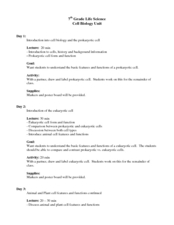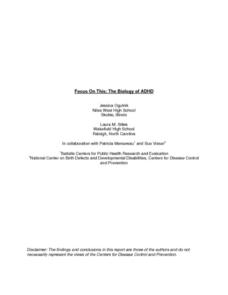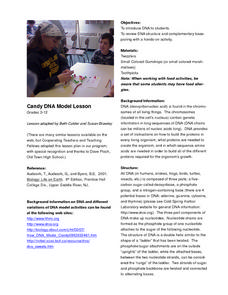Virginia Department of Education
Cell Parts
What do a bird, an egg, a rabbit, and a toad all have in common? This fun-filled resource explains the similarities and differences between cells and how all cells are similar, yet all are different. Learners begin by depicting a...
Curated OER
Cell (Biology)
High schoolers conduct a series of activities to explore the nature of cells. In this biology lesson, students observe plant and animal cells under the microscope and compare them. They differentiate osmosis and diffusion.
Curated OER
The Spanish Omelet
Young scholars use analogies to show the relationships among cell, nucleus, genes, chromosome, ribosome, replication, mitosis, transcription, translation, DNA, RNA, amino acids and proteins, genotype, phenotype, and genetics vs....
Curated OER
Cytoskeleton of a Cell
Students examine the cytoskeleton of a cell. They work together to build a structure with a certain number of materials. They share their "cell" with their classmates.
Curated OER
Human Cloning: Is it Biological Plagiarism?
Is cloning good or harmful? Help your class understand the risks and benefits as they read, research, and discuss human cloning. Individuals form teams, research information, and present to the class before concluding with an in-depth...
Curated OER
RNA
Young scholars explain how cells reproduce. In this biology lesson, students transcribe and translate a gene. They discuss and compare their answers in class.
Curated OER
How Can We Study the Differences in Animal and Plant Cells Using the Compound Microscope?
Students examine their cheek cells with a compound microscope. They identify different parts of the cell. They compare and contrast animal and plant cells with the microscope as well.
Curated OER
Cell Cookie Lesson Plan
Students review the structure and fuctions of plant and animal cells. They use various types of materials such as sugar cookies and cake frosting for this instructional activity.
Biology Corner
Cell Theory Rap
All that this will link you to is a rap about cell theory and organelles. Use it as an example for a creative assignment in your biology class. Divide the class into groups and assign them a topic for which they write and perform a skit,...
Curated OER
What Happens When A Cell Divides?
Students investigate the cycle of mitosis. In this biology lesson, students discuss the different stages of mitosis through cell reproduction. They further their investigation through laboratory analysis.
Curated OER
Games and Activities to Teach Molecular Genetics
Students demonstrate a working knowledge of cell interactions such as DNA replication, protein synthesis (transcription and translation), through active participation in a cooperative group.
Curated OER
The Biology of ADHD
Students investigate the biology of ADHD and its implications upon the formation and treatment of the disease. They draw and label the parts of a neuron. Also, they describe the neurotransmission cycle. Students create a list of pros and...
Curated OER
DNA, the Awesome Thread of Life
Students examine how traits are passed to offspring. In this genetic reproduction lesson students develop a model of dna and learn about its structure, replication and function.
Virginia Department of Education
Prokaryotes
Lead your biology class on a cell-sized adventure! Emerging scientists construct models of prokaryotes, then design an experiment to properly grow a bacterial culture. They conclude the activity by viewing the culture under a microscope....
Curated OER
Biology - Life Cycles Game
High schoolers develop a working vocabulary of terms related to the life cycle. In small groups, students play the life cycle's game which consists of matching and defining vocabulary. Directions for creating the game board are...
Curated OER
DNA on Stick
Students experience a "hands-on" activity to get visual evidence of the physical nature of DNA and the process of DNA purification. They explore one method of chromosomal DNA isolation and DNA extraction.
Curated OER
How Genes Work Lesson Plan
Students define the key terms that are the structure and function of DNA. In this genetics lesson students complete a lab activity in which they construct a model DNA structure.
Cornell University
Bacteria Take Over and Down
Bacteria outnumber all other forms of life on Earth. Scholars observe the growth of bacteria in petri dishes to understand their role in maintaining good health. Then, they observe the growth of bacteria after they introduce...
Curated OER
Brain Watching
Students identify the different parts of the nervous system. In this biology lesson, students research methods to diagnose and cure neurological disorders. They present their report to class.
Curated OER
Cloning And b-Galactosidase
Students investigate cloning using E coli cultures. Through laboratory exercise, they determine if E coli cells contain b - galactosidase.
Curated OER
What Are the Most Recent Developments in Animal and Human Cloning?
Students research the developments of animal and human cloning. They report their findings to the class. They write journal entries as well.
Curated OER
Amino Acids and Protein
Students study amino acids and discover the different proteins that are in our bodies. In this living environment lesson students build protein bracelets with beads as an example of the different amino acids.
Curated OER
Lesson on Proteins
Students examine the importance of proteins including their function and structure. In this protein lesson students play a game to help them better understand proteins.
Curated OER
Candy DNA Model Lesson
Young scholars explore DNA structure using materials such as Twizzlers, small colored gumdrops and/or toothpicks.























